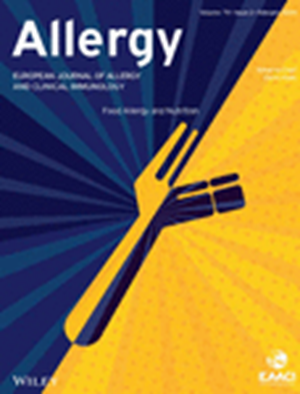The Dual Face of Wheat and Cereal Reactivity: Molecular Divergence Between Soluble and Gluten-Derived Allergens.
IF 12
1区 医学
Q1 ALLERGY
引用次数: 0
Abstract
BACKGROUND Cereal allergy comprises a heterogeneous spectrum of sensitization patterns directed toward water-soluble and gluten-derived proteins. The role of molecular cross-reactivity with homologous allergens from other cereals remains only partially understood. OBJECTIVE To investigate IgE reactivity to major wheat allergens (Tri a 14, Tri a 19, Tri a 30) and their homologs across cereals and pseudocereals, integrating bioinformatic, epidemiological, and clinical data. METHODS Sequence homology was assessed using BLAST analysis across cereal and pseudocereal proteomes. IgE reactivity was evaluated in 17,510 patients using two multiplex platforms (ImmunoCAP ISAC and ALEX2). Clinical data were available for 7201 individuals. RESULTS Tri a 14 displayed high sequence identity with multiple cereal nsLTPs, including a hitherto undefined maize-derived protein (72%), suggesting broad cross-reactivity, whereas Zea m 14 showed higher identity with Pru p 3 than with Tri a 14. Homologs of Tri a 30 and Tri a 19 were found in spelt and durum wheat. Sensitization to wheat allergens was rare (3.9%); Tri a 14 was the most frequent (64%), followed by Tri a 30 (23%) and Tri a 19 (18%). The limited cases of Tri a 14 or Tri a 19 were specifically associated with severe reactions and WDEIA. Limited co-sensitization indicated distinct IgE pathways to soluble and gluten-related proteins. CONCLUSIONS IgE profiling revealed distinct cross-reactivity patterns across cereals. Tri a 14 frequently co-sensitized with nsLTPs from both gluten-containing and gluten-free cereals, while Tri a 19 was exclusive to gluten-containing species. These findings support the need to expand molecular diagnostic panels to enhance clinical accuracy and guide dietary recommendations.小麦和谷物反应性的双面:可溶性和麸质源性过敏原的分子差异。
背景谷物过敏包括针对水溶性和谷蛋白衍生蛋白的异质致敏模式。与来自其他谷物的同源过敏原的分子交叉反应性的作用仍然只是部分了解。目的综合生物信息学、流行病学和临床资料,研究不同谷物和假谷物对主要小麦过敏原(Tri a 14、Tri a 19、Tri a 30)及其同源物的IgE反应性。方法利用BLAST分析方法对谷类和假谷类蛋白质组进行序列同源性分析。使用两种多重平台(ImmunoCAP ISAC和ALEX2)评估了17,510例患者的IgE反应性。7201人的临床数据可用。结果与多种谷物nsltp序列具有较高的同源性,其中包括一个迄今尚未确定的玉米源蛋白(72%),表明具有广泛的交叉反应性,而与Pru p3序列的同源性高于与Tri a 14序列的同源性。在斯佩尔特小麦和硬粒小麦中发现了Tri a30和Tri a19的同源物。小麦过敏原致敏罕见(3.9%);tria14是最常见的(64%),其次是tria30(23%)和tria19(18%)。tria14或tria19的有限病例与严重反应和WDEIA特异性相关。有限的共致敏表明IgE对可溶性蛋白和谷蛋白相关蛋白的通路不同。结论:sige图谱揭示了不同谷物间不同的交叉反应模式。Tri a 14经常与来自含麸质和无麸质谷物的nsltp共敏,而Tri a 19只与含麸质谷物共敏。这些发现支持扩大分子诊断小组以提高临床准确性和指导饮食建议的必要性。
本文章由计算机程序翻译,如有差异,请以英文原文为准。
求助全文
约1分钟内获得全文
求助全文
来源期刊

Allergy
医学-过敏
CiteScore
26.10
自引率
9.70%
发文量
393
审稿时长
2 months
期刊介绍:
Allergy is an international and multidisciplinary journal that aims to advance, impact, and communicate all aspects of the discipline of Allergy/Immunology. It publishes original articles, reviews, position papers, guidelines, editorials, news and commentaries, letters to the editors, and correspondences. The journal accepts articles based on their scientific merit and quality.
Allergy seeks to maintain contact between basic and clinical Allergy/Immunology and encourages contributions from contributors and readers from all countries. In addition to its publication, Allergy also provides abstracting and indexing information. Some of the databases that include Allergy abstracts are Abstracts on Hygiene & Communicable Disease, Academic Search Alumni Edition, AgBiotech News & Information, AGRICOLA Database, Biological Abstracts, PubMed Dietary Supplement Subset, and Global Health, among others.
 求助内容:
求助内容: 应助结果提醒方式:
应助结果提醒方式:


